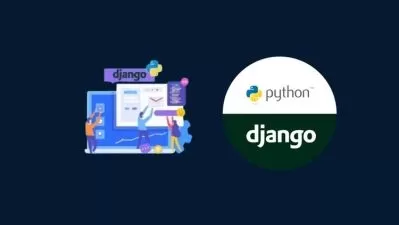About DjangoLearn More
Django is a web application development framework built on Python. Django provides ready made components to handle website management, authentication, file transfers, and more for web applications. This platform creates programs as varied as document management systems, mobile applications, machine learning tools, and much more. Udemy offers a vast selection of Django courses to help increase your app development skills.
Sort by:
Sorting
The newest
Most visited
Course time
Subtitle
Frequently asked questions about Django
Django is a Python-based Web Application Framework that follows the Model-View-Controller architectural pattern. As one of the most popular Web Application Frameworks available today, Django has an extensive amount of documentation and extensions available. It is also built primarily for data-driven websites. A non-profit organization and an active community of developers contribute to Django’s platform, which is both open-source and free. The advantages of using Django are rapid development and less code. Django also provides an administrative interface and many bundled components. Websites such as The Washington Times, Instagram, and Nextdoor used Django for development, and employers frequently seek Django developers and Python specialists for web development.
As an MVC Web Application Framework, many use Django to develop and deploy web applications rapidly. Django makes it easier for developers to hit the ground running rather than having to build the entirety of their platform from scratch. Mainly, Django is useful for those who are experts in Python — data models, settings, and files all use the Python language. In development since 2005, Django is a mature Web Application Framework with a significant amount of documentation and support, making its utilization attractive to those building complex, data-driven applications. Because Django is well-supported and robust, developers can use Django for large, enterprise-grade applications — but you can also use it for simpler applications.
Python programmers who are interested in a low code development prefer Django for its “don’t repeat yourself” model. Ideally, Django can create streamlined programs that require little coding to initialize. It has a significant body of architecture within its components and libraries, and you can administer it internally. Developers primarily use Django for web applications that need to balance large amounts of data and significant loads. Over 2,500 packages are available to extend Django’s behavior, making it a particularly robust platform. Developers interested in using Django can check to see if the functionality they desire already exists. Django is also often favored by full-stack developers who want to be able to build web applications from start to finish, as you can use it for both frontend and backend design.
Frontend design is related to what the user sees and interacts with. Backend is concerned primarily with the data. Django is both a frontend and backend Web Application Framework, unlike platforms like JavaScript’s Bootstrap, which you can use for frontend design. Django concerns itself primarily with the application’s interior workings, such as data manipulation, but is also useful for end-to-end frontend and backend design. A developer familiar with Django may be able to develop their web application “full-stack,” developing the entirety of the web application from front to back. However, frontend and backend work in Django can be separated if desired, meaning you can use Django for one or the other with some work. When separated in this way, Django is compatible with other frontend or backend technology.
There are both open-source, free Web Application Frameworks and commercial, proprietary frameworks. The latter is more expensive, but it will generally come with more support. Web Application Frameworks usually focus on a specific language. Django works with Python. Additionally, every Web Application Framework has its own level of complexity and learning curve, documentation, and support. Most web developers will want a Web Application Framework in a language they are fluent in. A solid library of extensions and plug-ins is also ideal as it reduces the amount of work the developer will need to do. Since the Web Application Framework has a lot to do with how a system functions, the system's look-and-feel may also come into play, as may other quality of life issues such as the robustness of the administrative panel.
The Model-View-Controller architectural pattern (MVC) is a type of software pattern for creating user interfaces. It standardizes how information flows through an application and makes it easier for developers to control all levels, from frontend to backend. Many Web Application Frameworks today follow the MVC model. Under the MVC architecture, the “model” refers to the data. The “view” refers to the display. Finally, the “controller” refers to the way that both models and views are updated. By retaining this consistency, multiple developers can also work together (both frontend and backend) without potentially retreading ground or overwriting essential items. The MVC model makes it easier to manage interconnected elements while ensuring that the application functions as a whole. MVC is compatible with desktop, mobile, and web application designs.
As a Python-based web framework, Django is primarily used by web developers. Because developers can use Django for both front- and backend web development, it's useful for frontend developers, backend web developers, and full-stack web developers. Large enterprises such as Instagram, Mozilla, and Pinterest are driven by Django and contribute to the Django community. Everyone from entry-level web developers to senior web architects can make a promising career with Django.
In the world of Python-based web frameworks, there are dozens of contenders. Flask is a popular Django alternative. Those who are new to web development may find Flask easy to adapt to, as its structure is clean and rigid. Both are based on Python, but Django requires more individualized knowledge. Another popular alternative to Django is TurboGears. TurboGears does not have the feature set of Django but has some extensive database management support. Other alternatives include Web2Py, Tornado, and CherryPy. When looking at Django, Flask, TurboGears, and other frameworks, it's important to contemplate a few factors: price, support, community, features, and integration. While many are better for niche situations, developers often consider Django to be the best all-around.









